Posts
-
Let's Read the Monster Manual 3: Spawn of Kyuss
This post is part of a series! Click here to see the others.
The Spawn of Kyuss were introduced in the Age of Worms adventure path, originally published in Dungeon Magazine in 2005-2006, when it was run by Paizo. Some of Kyuss’ most powerful servants were reprinted in the Elder Evils supplement for 3.5e, and later got conversion stats in an early 4th edition web enhancement file. This means this is technically not the Spawn’s 4e debut, but it is the first time we get complete lore and lower-than-epic stats for them.
The Lore
In ancient times, Kyuss was a mortal magician and a charismatic cult leader, who led his followers to a remote jungle region in order to establish a base. There, he found ruins from an even more ancient pre-human civilization. With the knowledge he learned from those ruins, the cultist sacrificed his followers in a ritual to become a giant undead demigod whose body was made out of bright green worms. The Worm that Walks spent a long time imprisoned outside the world, but the prophecy of the Age of Worms foretells that he will return and devour the world in what is basically a worm-fueled zombie apocalypse.
The Spawn of Kyuss are undead created by infecting corpses with worms plucked from his own body. They’re easily distinguished by the wriggling mass of green worms crawling all over them, inside and outside. They’re Kyuss’ agents in the world and their presence presages his return. Even if the Worm’s return is not imminent, these creatures might still be found performing some task that furthers their patron’s interests, whether by themselves or allied with cultists.
The first Spawn were Kyuss’ original followers, sacrificed in that first ritual. Making new ones is a matter of performing a simple worm transplant from a spawn to an available body, living or dead. The ones listed here are not particularly smart, but it’s worth remembering that Larva Mages are also the spawn of Kyuss.
The Numbers
We get three varieties of Spawn here, all suitable as threats to Paragon-tier parties. They’re Medium Natural Animates with a Speed of 5 and Darkvision, plus the usual undead traits: immunity to disease and poison, a resistance to necrotic damage, and a vulnerability to radiant damage. They’re also vulnerable to fire - it burns the worms right up.
All of the spawn here can also transmit the Touch of Kyuss, which is basically an infestation of evil supernatural worms. It’s treated as a Level 16 disease resisted with Endurance (DC 25 to improve or 20 to maintain). Stage 1 makes the victim regain only half hit points from spending healing surges, and causes them to rise as wretches of Kyuss if they die. Stage 2 causes them to lose 2 healing surges, and if they ever reach 0 surges they die and rise as Sons of Kyuss. Stage 3 cuts to the chase and kills the victim right away so it can rise as a Son.
Son of Kyuss
These things look like zombies at a first glance, but they’re sapient and much stronger. Their goal is to usually spread the “blessing” of Kyuss to as many living people as they can. Though they’re not exactly geniuses at Int 6, they can and will coordinate in order to accomplish it.
Sons of Kyuss are Level 13 Brutes with 158 HP. They project a Fear of Worms aura which inflicts a -2 attack penalty to living creatures inside. Their basic attack is a Slam that damages and exposes the target to the Touch of Kyuss. It can also “shoot” Burrowing Worms in a Close Burst 1 (recharge 5+). A hit inflicts 10 ongoing damage, increasing to 15 on the first failed save and to 20 plus stun on the second. If someone dies from this they immediately rise as a wretch of Kyuss (see below). The wretch must be destroyed before the victim can be raised.
Wretch of Kyuss
An undead creature with a lower worm content than a full Son of Kyuss. It’s less sturdy but still quite dangerous and quite contagious, being a Level 13 Minion Brute. Its Slam deals light necrotic damage, and when it dies it bursts, inflicting necrotic damage in a Close Burst 1 and exposing anyone hit by this attack to the Touch of Kyuss.
Herald of Kyuss
These undead abomination were created from the bodies of angels sent by the gods to stop the Worm that Walks. They’re Medium Immortal Animates (undead), and have all the same traits as the other spawn. Also, they can fly at speed 6.
The Herald is a Level 16 Artillery monster with 116 HP. They have the same Fear of Worms aura as the Son, plus a Writhing Host aura of the same size that deals 10 necrotic damage to enemies caught inside. All of their attacks expose the target to the Touch of Kyuss on a hit, making them the most contagious spawn of all.
Their basic melee attack is a Rotting Caress that deals necrotic damage. They can attack at range by making Writhing Pronouncements that deal immediate and ongoing 5 necrotic damage. This worsens to 10 and a daze on the first failed save, and to 15 and a stun on the second (save ends). People killed by this turn into wretches of Kyuss, which must be destroyed before the victims can be raised.
Once per encounter they can call an Eruption of Maggots that acts as a disgusting fireball-sized area attack. It deals immediate and ongoing necrotic damage, and also creates a damaging zone that lasts for the rest of the encounter.
Final Impressions
Ewwww. Kill these with fire as soon as possible. If your GM is re-enacting the Age of Worms campaign, you can expect to run into these things very often. Their main gimmick is all about infecting people with the Touch of Kyuss, so PCs can expect to stop and cast Remove Affliction more or less after every fight unless they’re under extreme time pressure. Stage 1 is already a major debuff, and staying at Stage 2 is a serious gamble.
-
Let's Read the 4e Monster Manual 3: Slaad
This post is part of a series! Click here to see the others.
Slaads have appeared in every 4e Monster Manual so far. This one gives us more exotic varieties.
The Lore
Basic slaad lore remains the same: technically sapient frog-like monsters from the Elemental Chaos with lolrandom minds and a propensity to implant eggs into other creatures. You can see the lore specific to each new variety in their descriptions below.
The Monsters
As a reminder, chaos phage is a level 16 disease that represents being implanted with a slaad egg. Stage 1 has no effect beyond this, stage 2 gives you a Will penalty and makes you attack randomly while bloodied, stage 3 means the embryo bursts out of your skull and kills you.
Like other diseases it’s not hard to remove with the right ritual, but the symptoms are severe enough that you’ll want to do it sooner rather than later. And as usual the ritual takes time and costs a bunch of healing surges, so it’s something that might add time pressure to a slaad focused adventure.
Golden Slaad
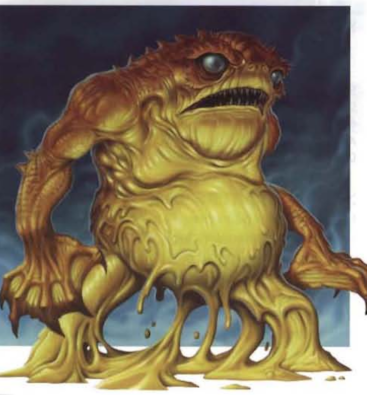
Copyright 2010 Wizards of the Coast. Slaads are mostly immune to the chaos storms that often rage through portions of the Elemental Chaos, which is why they like to follow these storms around. When one of these storms manages to affect a slaad, it can mutate it into a golden slaad. Golden Slaads are revered by their chromatic brethren, who follow them around as if they were a chaos storm themselves.
Golden slaads are even more chaos-infused than their relatives, and can inject that raw chaos in any victims they bite. Their gold-colored forms are unstable, and if they’re wounded they became unable to sustain those forms, becoming quivering (but still dangerous!) piles of ooze.
These creatures are Huge Elemental Humanoids and Level 20 Controllers with 193 HP. They have a ground speed of 8 and a teleport speed of 6, as well as low-light vision and an immunity to chaos phage (like all slaads).
Their bite is reach 3 and deals physical damage, with a random rider depending on the result of the attack roll. If the roll is odd, it slides the target 3 squares. If it’s even, it dazes them for a turn.
They can also emit Chaos Croaks in a Close Burst 5 (recharge 5+). This targets Will, does psychic damage, and has a random rider rolled on a d6 table:
-
Target is teleported 1d6 squares in a random direction (rolled on a d8).
-
Target makes a melee basic attack against a random creature adjacent to it.
-
Target is stunned for a turn.
-
Target is slowed (save ends).
-
Target takes an extra 10 damage of a random elemental type rolled on a d10.
-
Target is exposed to chaos phage, and if it was dazed by the slad it becomes stunned instead (save ends).
When the slaad is first bloodied it suffers an Amniotic Transformation and becomes an ooze. It becomes unable to teleport and its speed drops to 4, but it gains a Corrosive Pseudopodia attack that can be used as an opportunity action against any adjacent enemy who moves or makes an attack. It deals minor acid damage and grabs the target on a hit. With a minor action, the slaad can sustian all of its grabs, deal acid damage to the victims, and regain 5 HP per grabbed victim. So the loss of speed isn’t that crippling, because the slaad now wants people to get adjacent to it. And it still retains the use of its other attacks!
Putrid Slaad
This is an undead slaad. While it’s most often created on purpose by powerful necromancers, it can also arise naturally when a slaad dies in the Abyss. These “natural” putrid slaads have a tendency to obey demon lords, so you bet Orcus loves them.
The putrid slaad loses its ability to spread chaos phage, but it still fights very similarly to a living one. It will even eat its victims. The remains rot inside its non-functional guts, and then the monster vomits them when it attacks its next victims.
Putrid Slaads are Large Elemental Animates (Undead), and Level 19 Brutes with 227 HP. Its basic Claw attack pulls the target 1 square, and Graping Claws allows it to make 2 of those with a single action. If both attacks hit, the slaad grabs the victim.
Once the putrid slaad has grabbed someone, it will hit them with its Horrific Spew (recharge 6), which deals both immediate and ongoing acid and necrotic damage (save ends). The spew can also be used as a Close Blast 3 attack, but it has a +2 to-hit bonus when focused on the grabbed victim.
The slaad can also cast aside its grabbed victim, pushing them 5 squares, dealing some automatic physical damage to the victim, and using it to make an area attack against anyone adjacent to the victim when it lands.
Personal Impressions
More slaads. As far as late-edition slaads go, these are pretty cool mechanically. Golden Slaads finally deliver the promised dose of pure chaos people expect when they first read the slaad’s basic lore, and putrid slaads have this cool cycle of grabbing people and tossing them aside, with an occasional dose of disgusting barf.
-
-
Let's Read the 4e Monster Manual 3: Skulk
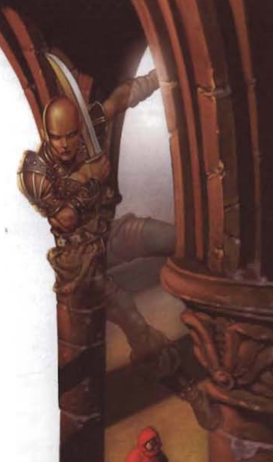
Copyright 2010 Wizards of the Coast. This post is part of a series! Click here to see the others.
Skulks first appeared on the AD&D Fiend Folio. This is their 4e debut, with all-new lore.
The Lore
Centuries ago, the human empire of Bael Turath fought a dreadful war against the dragonborn empire of Arkhosia. Bael Turath was never a nice place: its society was severely stratified, and its ruling nobles were slavers that spared little thought to those they enslaved. When it found itself losing the war against Arkhosia, those same ruling nobles did not hesitate to turn to Hell for help, and forged the diabolic pact that would see them and their descendants transformed into tieflings. We’ve seen all of this before, and we also know that the pact didn’t help them in the end. Bael Turath fell just the same, with the pact’s boon at most allowing them to take Arkhosia with them.
In this entry we see one of the reasons why it fell. The pact for infernal power excluded Bael Turath’s large enslaved population, even as it lowered the slavers’ guard. There was a huge rebellion where many of Bael Turath’s noble caste were murdered in their sleep. Some of the rebels did this to escape their bonds, but some did it because they were angry at being excluded from the infernal pact. The Demon Prince Graz’zt was impressed with the latter and reached out to them to offer his patronage. Those who accepted became the creatures known as skulks.
Skulks are sapient humanoids with a supernatural affinity for stealth. Ironically enough, they are much more indebted to their demon patron than modern-day tieflings are to whatever devil mutated their ancestors. This eternal debt is encoded in a document known as the Book of the Blinded Eye, and it bids even present-day skulks to follow the orders of Graz’zt’s servants. They’re often sent out as assassins to eliminate threats to the cult or their demon master.
The skulks’ hatred of tieflings is equally eternal, and probably also enforced by the demonic pact. Skulks live as if Bael Turath never fell, and as if they’re still infiltrated behind enemy lines. Left to their own devices, they will pursue their original mission of murdering all tieflings. They spread along with the tiefling diaspora as the latter fled their fallen empire. Any present-day settlement that contains a sizable tiefling population is also likely to contain a skulk population preying on them.
The book paints all skulks with this demonic brush, but it would be simple to say only a small percentage of them are this horrible, just like only a small percentage of tieflings are diabolists. As with most other humanoid entries, you can treat this one describing the form skulk villains usually take, and not as a species-wide portrayal.
I imagine non-evil skulks would simply be reclusive and wish to be left alone, either living in their own isolated communities or still “infiltrating” those of others but without trying to murder anyone.
The Numbers
Skulks are Medium Natural Humanoids with a ground speed of 6 and Low-Light Vision. Their signature trait is Stealthy Step, which exempts them from the Stealth penalty for moving more than 2 squares per turn or for running. All of the individual entries have additional stealth powers beyond that, appropriate to their role.
The entries here are appropriate threats for an early-to-mid-Heroic party. More powerful skulks up to epic tier certainly exist, but are left as an exercise to the GM.
Skulk Mesmerist
A spellcaster specializing in charm and illusion magic. It’s a Level 3 Controller with 45 HP. Mesmerists fight with a short sword and have a couple of active attack powers. The first is Luring Charm, a non-damaging ranged attack that targets Will, slides the target 4 squares, and dazes then for a turn. The other is Mesmerize (recharge 5+) a ranged attack that targets Will, deals psychic damage, and makes the target unable to see any enemies other than the mesmerist themselves (save ends).
As a minor action, they can also use Deceptive Veil to look like any Medium or Small humanoid. Piercing the illusion requires a DC 26 Insight check, which is very hard even for a dedicated PC at this level. This is actually more powerful than the Changeling’s disguise ability, since it also allows the mesmerist to look like a Small humanoid.
Skulk Mesmerists like to kill two birds with one stone by murdering a target while looking like someone they want to frame for that murder. Their Veil also makes it possible for the GM to make an adventure where an innocent changeling is charged for a string of murders perpetrated by a skulk mesmerist.
Skulk Murderer
This one does what it says on the tin. Over and over and over. It’s a Level 3 Lurker with 37 HP.
Aside from the standard Stealthy Step trait, the murderer also has Peerless Camouflage that allows it to hide while it only has partial cover or concealment, and to remain hidden if it still has cover or concealment at the end of a movement. It also has Unseen Strike, which lets it deal extra damage against targets that couldn’t see at the start of its turn.
The murderer fights with a Short sword and can thrown a Shuriken Volley once per encounter. This lets it make three ranged attacks, which deal a bit of damage and immobilize (save ends) on a hit. All of these can benefit from Unseen Strike.
When playing one of these, you want to start the fight hidden and open it with a Shuriken Volley. Then you alternate between re-establishing stealth and striking with the sword. A mesmerist in the same team as the murder makes it a lot more dangerous, because now the murderer doesn’t need to waste time hiding to benefit from Unseen Strike.
Skulk Hunter
Another stealthy killer, but this one is a Level 5 Soldier with 61 HP. It fights with a longsword, and even its basic attack is funny: it’s called Baffling Blade, and it if hits it allows the hunter to stay hidden from the target. Its special attack is the Invisible Blade (recharge 5+), which targets someone who can’t see the hunter, deals double damage, and inflicts ongoing 5 damage (save ends).
Both attacks mark the target as an effect, and if an enemy marked by the hunter shifts the hunter gets to use Baffling Blade against them.
Hunters also go very well with mesmerists: the mesmerist can make them invisible to a PC while they set up as the traditional front line preventing the PC from reaching the mesmerist. They can use Invisible Blade against the afflicted victim without having to hide, and they can also hide without having to leave formation.
Final Impressions
As I mentioned in the lore entry, I like this entry much better if I read it as describing the typical skulk villain instead of describing the typical skulk. Mechanically, I like how the three stat blocks synergize - they’re clearly meant to be used together.
Allied monsters might include Graz’zt cultists and minor demons. Anything that can make their monster buddies invisible also works really well with skulks.
-
Let's Read the 4e Monster Manual 3: Shardmind
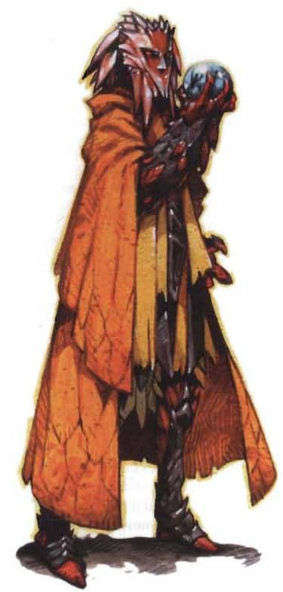
Copyright 2010 Wizards of the Coast. This post is part of a series! Click here to see the others.
Shardminds made their debut as a playable option in the Player’s Handbook 3 for 4e. They’re new to this edition and really lean into its background lore for psionics. They also have the honor of being the second living construct species presented in the game (after Warforged). This entry presents some shardmind stat blocks for use as NPCs or enemies.
The Lore
At the dawn of time there was a crystaline entity named the Living Gate. Neither god nor primordial, the Gate protected the border between the known planes and the Far Realm. It stood firm even during the Dawn War, but it was eventually sundered by the combined efforts of mind flayers, beholders and other Far Realm inhabitants who wanted to enter the world for reasons ranging from the inscrutable to the foul.
Though the Living Gate was shattered and its pieces spread through the cosmos, its will lived on, gifting the disparate shards with life and purpose. These are the shardminds, living constructs with a strong affinity for psionic power and ancestral memories that compel them to rebuild the Living Gate and once again seal the Far Realm away.
Despite that common ancestral memory shardminds as individuals are as varied in outlook and personality as any other sapient species. Over the ages they have formed three major schools of thought that propose different ways of continuing the mission of the Living Gate. The MM3 doesn’t describe all of them, but I will because they’re cool.
The Thought Builders believe the correct solution is to build a new Living Gate and imbue it with the psionic power necessary to seal the Far Realm. Their main goal is to acquire the knowledge necessary to do so. They tend to be Good and worship Ioun.
The God Shards believe that the Shardminds now form a distributed network that carries on the duties of the Living Gate. It’s each individual’s duty to train and nurture their own power so that they can better contribute to this task. Once this network is strong enough, the Far Realm will be sealed. They tend to be Unaligned and worship no gods.
The Shard Slayers are the faction most likely to come into conflict with the PCs. They believe that the original Living Gate can rebuild itself if it’s psionic energy is allowed to return to its original site. However, this energy is “trapped” in the shardminds, and must be forcibly “released”. So yeah, adherents of this philosophy want to kill all other shardminds and then themselves. They are usually Evil and worship Vecna.
The stat blocks in this entry represent Shard Slayers suitable as mid-to-late Heroic opposition. If your group has one or more shardminds, they have a built-in reason to be hostile. Even if it doesn’t, most non-Evil PCs will be interested in stopping a bunch of genocidal maniacs.
The Numbers
Shardminds are Immortal Humanoids with the Living Construct keyword. They have Resist 5 Psychic and a ground speed of 6. Their signature power is the same one PCs get: Shardswarm, an encounter power which allows them to break apart and reform a short distance away. This causes every adjacent enemy to grant combat advantage for a turn and lets the shardmind teleport half their speed.
Shardminds speak Common, Deep Speech, and have telepathy with range 5.
Shardmind Warseeker
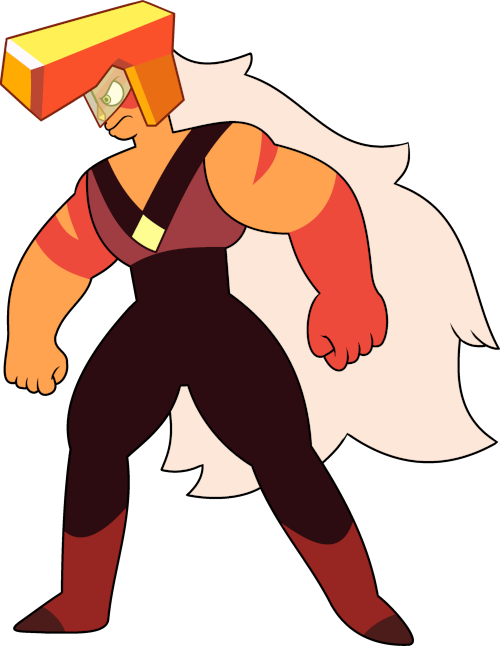
Jasper, from Steven Universe. This psychic warrior disguises its true nature beneath a suit of plate, and wanders about seeking shardminds to slay. Its outwardly calm demeanor hides a murderous rage, which reveals itself when it’s wounded in combat or when an innocent bystander fails to answer its questions.
The warseeker is a Level 6 Soldier with 70 HP. It wears plate and fights with a broadsword and a heavy crossbow. Heavy armor means its speed is only 5.
Both the sword and the crossbow are basic attacks that damage and mark for a turn. If a marked enemy within 5 squares of the warseeker targets makes an attack that doesn’t target it, the warseeker can deal 5 psychic damage to that enemy. Once the warseeker is bloodied, its Furious Mind grants it 10 temporary HP, a -2 penalty to AC, and a +4 bonus to damage for the rest of the fight.
This is a basic frontline fighter with some tricks borrowed from the paladin and the barbarian. It’s sticky and a good choice to form a solid “wall” with other soldiers and brutes.
Shardmind Dominator
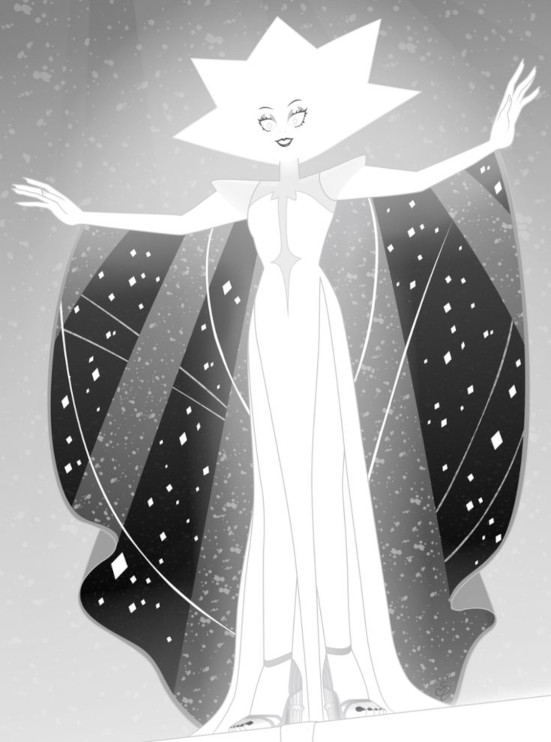
White Diamond, from Steven Universe. A psion who is a big fan of mind control. It’s a Level 8 Controller with 86 HP. It wields a dagger as a basic melee attack, but the important bits are its powers geared towards brute-force mind control.
Overwhelming Mind is an at-will power that only has an “Effect” line, meaning this always happens: it forces an enemy within 5 squares to make a melee or ranged basic attack against a target of the dominator’s choice. If the attack hits, the dominator slides the enemy 3 squares. Psionic Puppet (recharge 5+) is a non-damaging ranged attck that dominates the target on a hit (save ends). And Mind Swarm (encounter) is an area attack that deals psychic damage and creates a zone that lasts the rest of the encounter. Enemies who end their turn inside can be slid 3 squares by the dominator.
Dominators will be doing little damage on their own, but they’ll cause lots of friendly fire incidents and will make it very hard for the party to maintain any sort of coherent formation.
Shardmind Executioner
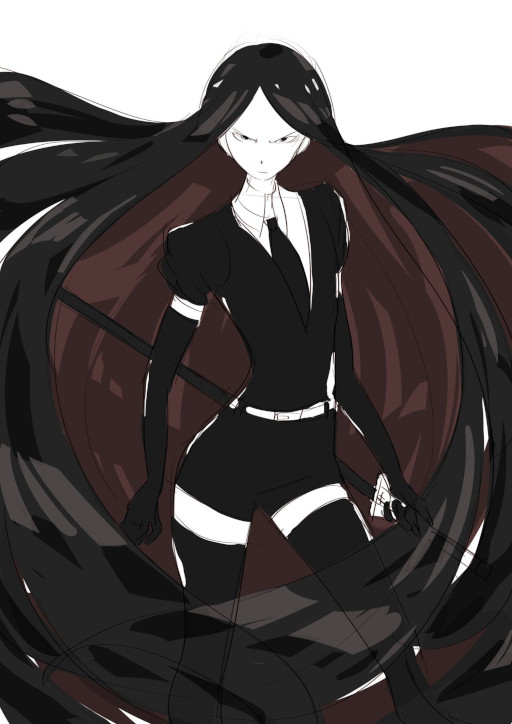
Bort, from Land of the Lustrous. A skilled assassin dispatched to murder shardminds identified by its buddies. It’s a Level 10 Lurker with 81 HP, wielding a crystal greatsword called a Shardblade. It does standard damage for its level, which can be increased by the Psychic Boost (recharge 5+). This is a free-action power that triggers when the executioner hits with the sword, so it’s never wasted on a missed attack.
The executioner attacks a range with a Mind Shadows power, which deals light psychic damage and blinds the target for a turn. It can also perform a Psychic Infiltration, a melee attack vs. Will. On a hit this removes the executioner from play and causes the target to suffer 20 ongoing psychic damage and be dazed (save ends). When the target saves, the executioner appears adjacent to it. This is an at-will power.
A boosted sword strike actually deals more damage than a round of Infiltration, but the latter is an excellent move to use while Psychic Boost recharges, as it shields the shardmind from damage. So this lurker actually hides inside the enemy’s minds, and deals massive damage while doing so.
Final Impressions
I love all the living constructs, and shardminds are no exception. Their default appearance is a bit meh, but as you can see by the illustrations I chose here this can be easily remedied.
-
Let's Read the 4e Monster Manual 3: Shadow
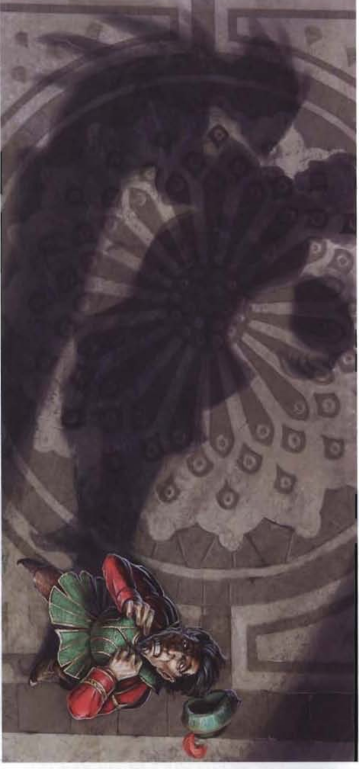
Copyright 2010 Wizards of the Coast. This post is part of a series! Click here to see the other.
Shadows have been in the game since the beginning. They were usually undead in previous editions, but here they get a bit of new lore.
The Lore
It’s understandable that someone would think shadows are undead, but the truth is that they are a species of creature native to the Shadowfell. They’re sapient but they perceive the world in a way that makes then inimical to most other living creatures. They hate light, and believe the shadows cast by living creatures to be prisoners in cages of flesh. Many seek to rescue these prisoners by destroying their cages.
Shadows might form alliances of convenience with other people that would offer them the chance to “liberate” lots of living creatures, but they rarely care for the causes or gods of us fleshlings. The exception seems to be spellcasters versed in shadow magic, who can summon them very easily and always find them to be obsequious and eager servants. It’s almost like the shadows know something that these mortal masters don’t.
Shadows slip into the world via these summonings or at natural contact points between the world and the Shadowfell. Their number has increased in recent years, but no one knows why yet.
The Numbers
Shadows are Medium Shadow Humanoids with a ground speed of 8 and Darkvision. They’re insubstantial but vulnerable to radiant damage. Exposure to ambient light doesn’t damage them, but reveals their position and leaves them with less places to hide.
Their signature trait is Born of Shadows, which allows them to make Stealth checks to hide mid-combat when they have any amount of concealment, instead of needing total concealment. All of the variants here are trained in Stealth.
Shadow Stalker
This one is equivalent to the classic shadows of editions past. It’s a Level 3 Lurker with 25 HP.
The stalker attacks with a shadowy touch that does necrotic damage, and it has a Shadow Stalk power that deals necrotic damage and allows it to meld with an enemy’s shadow (save ends). While melded, the shadow moves in lockstep with its victim, without provoking opportunity attacks. It gains a +4 to all defenses and a +5 to attack the victim. When the victim saves, the shadow appears on an adjacent square.
Its triggered action is Shadow Step: when a nearby creature drops to 0 HP, the stalked teleports to an adjacent square and gains a +2 bonus to attacks for a turn (from eating the victim’s shadow). This also recharges Shadow Stalk.
Shadow Stalkers become major threats if they manage to land their Shadow Stalk attack. Its buddies should focus fire on the stricken PC, which increases the chances of the PC dropping to 0 HP and recharging the power. Note that it’s possible for multiple stalkers to meld with the same PC’s shadow, and that the attack also recharges if an enemy hits 0 HP.
PCs should focus their fire on any shadow stalkers in Team Monster, preferrably with radiant and force attacks to kill them quicker.
Shadow Strangler
This is a spellcaster specializing in remote shadow control. It uses the shadows it devours to fuel its magic, so it must feed more frequently than its fellows. Stranglers are Level 9 Artillery with 53 HP.
The Strangler’s shadowy touch deals necrotic damage and makes invisible to the target for a turn. Its basic ranged attack is a spell namd Blinding Shadows that deals the same amount of necrotic damage and makes the target unable to see further than 3 squares for a turn. Its special attack is Strangling Darkness (recharge 5+) which restrains and deals ongoing 15 damage (save ends). And finally it has an encounter power named Devouring Dark that’s basically a “shadow fireball” that deals light necrotic damage and blinds everyone it hits for a turn.
Despite being artillery, stranglers are very controllery. They pair well with lurkers whose increased damage depends on combat advantage or on being unseen by their targets.
Shadow Puppeteer
This powerful shadow has a more refined palate. It seeks to feed on the shadows cast by souls as they depart for the afterlife. So while the others might leave their victims a bit drained but alive, this one is definitely out for murder.
Puppeteers are Level 14 Lurkers with 74 HP. Their shadowy touch deals extra damage against targets that cannot see it, and creates a zone of lightly obscured squares centered on the target’s space that lasts for a turn. Its special attak is Shadow Puppet, which targets a creature that cannot see the puppeteer, deals light necrotic damage, and dominates them until they start their turn not adjacent to the shadow.
Puppeteers and stranglers have amazing synergy. If you want your PCs to sweat for their victory, it’s definitely worth it to adjust their levels so they’re closer to each other and can be included in the same encounter. Keep the strangler as the lower-level half of the pair to make things slightly less hard for them.
PCs fighting a puppeteer should remain mobile to avoid lingering in the darkness it creates, and should use forced movement powers to keep it away from potential domination targets. If they face the tag team described above, they should focus on killing the strangler first, since it frees the puppeteer from having to set up its lurker bonuses.
Final Impressions
Shadows don’t usually work well with other monsters, so you’re most likely looking at all-shadow teams when building encounters. If you want more variety it might be possible to turn another monster into a shadow by changing its origin, halving its HP, making it insubstantial, and making its basic attack into a touch that targets Reflex and deals necrotic damage.
The original reason shadows were scary was that they drained Strength, but here they’re scary because they’re sticky. The basic stalker can enter your shadow and attack you from there until it kills you. The puppetter does the same but dominates you to attack your friends while it’s doing it. And the strangler makes it a lot easier for the other two to do their part.
subscribe via RSS